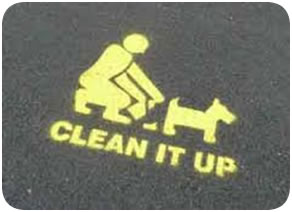RiteView Solutions Ltd has developed an Anti-Dog Fouling Device which has been proven to reduce dog fouling in public areas by 82%. Many Local Authorities are adopting this new technology and are experiencing a reduction in dog fouling and positive feedback from communities.
RiteView Solutions offers the following services to Local Authorities to address dog fouling…
- Anti-Dog Fouling Devices: Proven to reduce fouling by 82% through enhancing public awareness and changing behaviour. The devices can be deployed rapidly and can be easily rotated between locations.
- ‘Paw-Fall’ Data analytics: RiteView Solutions can develop a clear understanding of dog traffic in your area. For example, how many dogs per hour across one week use the targeted area? What is the percentage of dog walkers? What times would dog wardens make the greatest impact? Etc.
- Dog foul trends: Measure the current situation and repeat measurements as dog fouling initiatives are implemented.
- Path Stencilling / Signage: RiteView Solutions offers customised path stencils and signage to support anti-dog fouling initiatives.
Why is dog fouling a concern?
Dog fouling in public areas is a challenge across many Local Authorities. It is unpleasant and also dangerous. The biggest threat to public health from dog foul is toxocariasis. This is an infection of the roundworm toxocara canis. The eggs of the parasite can be found in dog foul or contaminated soil / sand. Symptoms include blindness, nausea, asthma and, in extremely rare cases, seizures/fits. Children under five years are most at risk of infection.
Note: Section 22 of the Litter Pollution Act 1997 requires the person in charge of a dog to clean up when their dog fouls in a public place. Freshly deposited faeces are not infectious because toxocara eggs do not become infectious for at least 2 – 3 weeks after the faeces have been deposited. Therefore there is no risk of catching toxocariasis whilst clearing up immediately after your dog.
Dog fouling in public areas is a challenge across many Local Authorities. It is unpleasant and also dangerous. The biggest threat to public health from dog foul is toxocariasis. This is an infection of the roundworm toxocara canis. The eggs of the parasite can be found in dog foul or contaminated soil / sand. Symptoms include blindness, nausea, asthma and, in extremely rare cases, seizures/fits. Children under five years are most at risk of infection.
Note: Section 22 of the Litter Pollution Act 1997 requires the person in charge of a dog to clean up when their dog fouls in a public place. Freshly deposited faeces are not infectious because toxocara eggs do not become infectious for at least 2 – 3 weeks after the faeces have been deposited. Therefore there is no risk of catching toxocariasis whilst clearing up immediately after your dog.


